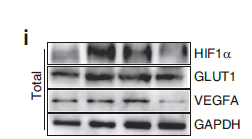
主要信息
Target
Keap1
Host Species
Rabbit
Reactivity
Human, Mouse, Rat
Applications
WB, IHC, IF, ELISA
MW
70kD (Calculated)
60-70kD (Observed)
Conjugate/Modification
Unmodified
货号: YM8283
规格
价格
货期
数量
200μL
¥3,780.00
现货
0
100μL
¥2,300.00
现货
0
40μL
¥960.00
现货
0
加入购物车


已收藏


收藏
详细信息
推荐稀释比
IHC 1:200-1:1000; WB 1:2000-1:10000; IF 1:200-1:1000; ELISA 1:5000-1:20000;
组成
PBS, 50% glycerol, 0.05% Proclin 300, 0.05%BSA
特异性
Endogenous
纯化工艺
Protein A
储存
-15°C to -25°C/1 year(Do not lower than -25°C)
理论分子量
70kD
实测条带
60-70kD
修饰
Unmodified
克隆性
Monoclonal
克隆号
PT0444R
同种型
IgG,Kappa
相关产品
抗原&靶点信息
特异性:
Endogenous
展开内容
基因名称:
KEAP1 INRF2 KIAA0132 KLHL19
展开内容
蛋白名称:
Kelch-like ECH-associated protein 1 (Cytosolic inhibitor of Nrf2) (INrf2) (Kelch-like protein 19)
展开内容
别名:
KEAP1 ;
INRF2 ;
KIAA0132 ;
KLHL19 ;
Kelch-like ECH-associated protein 1 ;
Cytosolic inhibitor of Nrf2 ;
INrf2 ;
Kelch-like protein 19
INRF2 ;
KIAA0132 ;
KLHL19 ;
Kelch-like ECH-associated protein 1 ;
Cytosolic inhibitor of Nrf2 ;
INrf2 ;
Kelch-like protein 19
展开内容
背景:
kelch like ECH associated protein 1(KEAP1) Homo sapiens This gene encodes a protein containing KELCH-1 like domains, as well as a BTB/POZ domain. Kelch-like ECH-associated protein 1 interacts with NF-E2-related factor 2 in a redox-sensitive manner and the dissociation of the proteins in the cytoplasm is followed by transportation of NF-E2-related factor 2 to the nucleus. This interaction results in the expression of the catalytic subunit of gamma-glutamylcysteine synthetase. Two alternatively spliced transcript variants encoding the same isoform have been found for this gene. [provided by RefSeq, Jul 2008],
展开内容
功能:
Disease:Defects in KEAP1 may be a cause of breast cancer.,Disease:Defects in KEAP1 may be involved in non small cell lung carcinomas (NSCLC) and lung adenocarcinoma.,Domain:The Kelch repeats mediate interaction with NF2L2/NRF2, BPTF and PGAM5.,enzyme regulation:Ubiquitination and subsequent degradation of PGAM5 is inhibited by oxidative stress and sulforaphane.,Function:Retains NFE2L2/NRF2 in the cytosol. Functions as substrate adapter protein for the E3 ubiquitin ligase complex formed by CUL3 and RBX1. Targets NFE2L2/NRF2 for ubiquitination and degradation by the proteasome, thus resulting in the suppression of its transcriptional activity and the repression of antioxidant response element-mediated detoxifying enzyme gene expression. May also retain BPTF in the cytosol. Targets PGAM5 for ubiquitination and degradation by the proteasome.,PTM:Ubiquitinated and subject to proteasomal degradation.,similarity:Contains 1 BACK (BTB/Kelch associated) domain.,similarity:Contains 1 BTB (POZ) domain.,similarity:Contains 6 Kelch repeats.,subcellular location:Shuttles between cytoplasm and nucleus.,subunit:Homodimer. Interacts with the N-terminal regulatory domain of NF2L2/NRF2. Interacts with BPTF and PTMA. Interacts with CUL3. Part of a complex that contains KEAP1, CUL3 and RBX1. Interacts with PGAM5.,tissue specificity:Broadly expressed, with highest levels in skeletal muscle.,
展开内容
细胞定位:
Cytoplasm, Nucleus
展开内容
研究领域:
>>Ubiquitin mediated proteolysis ;
>>Parkinson disease ;
>>Pathways in cancer ;
>>Chemical carcinogenesis - reactive oxygen species ;
>>Hepatocellular carcinoma ;
>>Fluid shear stress and atherosclerosis
>>Parkinson disease ;
>>Pathways in cancer ;
>>Chemical carcinogenesis - reactive oxygen species ;
>>Hepatocellular carcinoma ;
>>Fluid shear stress and atherosclerosis
展开内容
信号通路
文献引用({{totalcount}})
货号: YM8283
规格
价格
货期
数量
200μL
¥3,780.00
现货
0
100μL
¥2,300.00
现货
0
40μL
¥960.00
现货
0
加入购物车


已收藏


收藏
Recently Viewed Products
Clear allToggle night Mode
{{pinfoXq.title || ''}}
Catalog: {{pinfoXq.catalog || ''}}
Filter:
All
{{item.name}}
{{pinfo.title}}
-{{pinfo.catalog}}
主要信息
Target
{{pinfo.target}}
Reactivity
{{pinfo.react}}
Applications
{{pinfo.applicat}}
Conjugate/Modification
{{pinfo.coupling}}/{{pinfo.modific}}
MW (kDa)
{{pinfo.mwcalc}}
Host Species
{{pinfo.hostspec}}
Isotype
{{pinfo.isotype}}
产品 {{index}}/{{pcount}}
上一个产品
下一个产品
{{pvTitle}}
滚轮缩放图片
{{pvDescr}}























